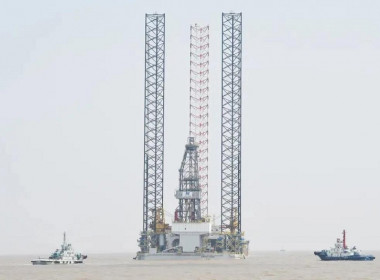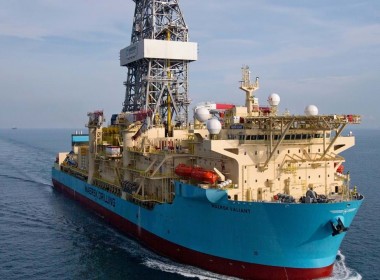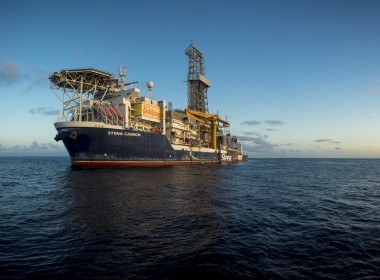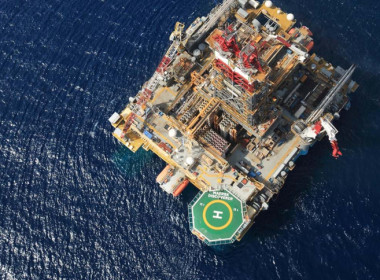COLUMN | Falling Knives and Walking Away: Sete Brasil, Petrobras, Keppel Corp., Knarr Drilling and Magni Partners [Part Two]

Last week we looked here at how China State Shipbuilding Corporation has decided to restart work on a pair of unfinished deepwater drilling rigs in Shanghai Shipyard at the same time that modern drillships are being scrapped – or bought for scrap prices and converted as space rocket launch facilities by Elon Musk’s SpaceX (here). Adding capacity to a drilling market with drastic overcapacity makes no economic logic. But it protects jobs in China and avoids embarrassing asset write-downs on the books of the shipyard.
Brazil tries to restart work
However, it is not only China where good money is being thrown after bad. Brazil, too, is trying to orchestrate the revival of stalled drilling rig construction, even though the world already has too many drilling rigs, and drilling contractors are going bust left, right and centre (here).
Worse, Brazil’s domestic rig building programme is so tainted with corruption it has led to hundreds of millions of dollars of fines being levied on the participants, huge losses for the shipyards involved, and prison sentences for many of the individuals implicated. Court cases continue.
Unfinished rigs find Norwegian saviour?
Today, four nearly finished deepwater drilling units sit silently in Brazilian yards owned by Singaporean rig builders Keppel O&M and SembMarine, close to completion and commissioning, but not just yet. Singapore’s sovereign wealth fund, Temasek Holdings, is now the largest shareholder in both yards.
The company that ordered the rigs has long gone bankrupt, and its operations manager languishes in jail. The Singaporean shipyard owners have taken large write-downs on the partially finished units. Banks have written off the loans that financed the first phases of the construction.
Now Norwegian investors at Magni Partners have emerged to buy the rigs, finish them and put them on hire in Brazil. This is the same team behind Borr Drilling. This is a bad idea on so many levels.
How did we get here?
To understand how we reached such a place we need to understand how Brazil began such a huge but ultimately ill-fated domestic rig-building drive.
Petrobras’ pre-salt success
In 2006, Brazil’s state-owned oil company, Petrobras, made a massive deepwater oil discovery known as Tupi in the Atlantic in more than 2,000 metres of water depth, beneath a thick layer of prehistoric salt, which had never previously been successfully drilled offshore in the Americas. This triumph in pre-salt exploration led to a remarkable run of discoveries for Petrobras.
The reserves were real and Petrobras spent billions to bring them to production in the years that followed. By 2019 the company was producing more than two million barrels of oil a day from the pre-salt reservoirs of the Santos and Campos basins, from over 150 wells (here) and sixteen FPSOs.
Budget increases twelve thousand per cent
Such huge discoveries led to a radical expansion of Petrobras’ spending. In 2007, before Petrobras began to invest in the development of the pre-salt discoveries, the company’s engineering division had a budget of just US$3 billion a year; by 2011, it had ballooned to US$3 billion a month as the company ramped up spending on pre-salt activities.
As the deepwater pre-salt discoveries piled up, Petrobras’ forecasts showed that it would need dozens of rigs to bring the fields to production. At that time, deepwater rigs were being chartered for over half a million dollars a day apiece, and each cost over US$600 million to build in shipyards in Korea.
Lula sees an opportunity for a national champion
Petrobras’ senior management and the government of Brazil, under the Workers’ Party of president Luiz Inácio “Lula” da Silva, spotted an opportunity. What if the company could set up a new national drilling contractor to build the rigs it needed at home in Brazil? This would stimulate jobs in domestic shipyards and would enable Petrobras itself to benefit from the profits of the drilling, rather than overseas contractors like Transocean, Seadrill and Diamond making the profits.
Sete Brasil is born
This simple vision became a company known as Sete Brasil, set up in 2010. Unfortunately, there was one flaw to the plan. “The payment of bribes in Petrobras was something endemic and institutionalised,” a participant later testified.
As much as creating a national drilling champion, Sete would also provide a stream of lucrative bribes to Petrobras managers and the Workers Party itself.
Sete brings together dream team (for kickbacks)
João Carlos de Medeiros Ferraz was appointed president of Sete Brasil, whilst a former Petrobras engineering services manager named Pedro José Barusco Filho became “operations manager,” liaising between Sete and his former employer, Petrobras, Sete’s sole customer. The primary operation in which Mr Barusco was involved was actually the payment of bribes, however.
Petrobras set about awarding Sete long-term, ten- to twenty-year contracts for new-build rigs so that its affiliate would become the world’s largest deepwater drilling rig company. A PowerPoint presentation of Sete’s audacious business plan can be seen here.
US$89 billion in long-term charters make compelling business case
This made Sete an attractive investment. Alongside Petrobras, a number of high-profile, blue chip institutions were encouraged to invest in Sete. Shareholders included two of Brazil’s biggest, publicly listed, private sector banks (BTG Pactual and Bradesco), Spanish bank Santander, an American fund named EIG, and a number of other Brazilian pension and investment funds.
Additionally, Sete encouraged both domestic and international drilling contractors to invest in individual rig-building projects in return for the right to operate the drilling units upon delivery. Both Seadrill and Odfjell Drilling took equity in individual Sete-controlled rigs, with Seadrill taking a 30 per cent stake in three drillships ordered from SembMarine’s local yard, and Odfjell a 10 per cent stake in another three units.
Odfjell is reported to have invested around US$9 million in the newbuildings before – spoiler alert – they were cancelled.
Huge contracts for five lucky yards
The numbers are mind-boggling. Sete won contracts with Petrobras worth US$89 billion for 28 ultra-deepwater drilling rigs in the period 2011 to 2014, with another two in the pipeline. Sete awarded contracts at five Brazilian shipyards worth US$22 billion and hoped to create 150,000 jobs.
Three of the yards were Brazilian-owned with Japanese investors: Estaleiro Atlantico Sul, Estaleiro Rio Grande, and Estaleiro Enseado Industria Naval. The other two were Singaporean-owned: Keppel O&M’s BrasFels, and SembMarine’s Estaleiro Jurong Aracruz, which were awarded six and seven newbuild rig contracts, respectively, worth over US$5 billion to each yard.
Rousseff sees a new dawn
In 2012, Brazil’s President Dilma Rousseff visited Estaleiro Rio Grande, and addressed the workforce of four thousand.
“Here in Rio Grande do Sul we have seen the birth and growth of a shipbuilding industry,” she told them. It wasn’t to be.
Mr Barusco sees a Swiss banker
Right from the start, Mr Barusco set about using Sete as a vehicle for corruption. In October 2011, he, his current boss, Mr Ferruz, and his former boss at Petrobras, Renato de Souza Duque, who was then director of engineering services, travelled to Milan to meet a Swiss banker for dinner, the Financial Times reported (here).
The Brazilians wanted to open bank accounts at Banque Cramer to receive commissions from the five shipyards. The Swiss were happy to oblige. In order to win the 30 rig-building contracts which Sete was planning to award, (two with OSX Shipyard were never consummated), the conspirators demanded commissions of 0.9 per cent of the contract values from the yards, more than US$200 million.
Rinse and repeat scheme (at the Car Wash)
It was not the first time Mr Barusco had organised such a scheme with Mr Duque. After he was arrested, Mr Barusco offered to reimburse Petrobras around US$100 million, which he claimed to have received as bribes between 2003 and 2013. He stated in sworn testimony that as well as Mr Duque and Mr Ferruz, and of course, himself, a major recipient of the bribes from Sete was João Vaccari Neto, the treasurer of Ms Rousseff’s Workers’ Party.
Indeed, the deal between the conspirators was that Mr Vaccari would receive two thirds of the bribe money, whilst the Petrobras and Sete managers would receive only one third. This was part of a massive bribery scandal known as “the Car Wash scandal,” which went to the heart of the Brazilian political establishment. The Car Wash would bring down Ms Rousseff as president, and lead to her predecessor, Mr Da Souza, being jailed, whilst people rioted in the streets.
Mr Barusco claimed that he had already paid US$200 million to Mr Vaccari in bribes in the decade up to 2013. He wasn’t the only one. The Swiss Attorney General’s office confirmed in October 2020 that it had around 40 criminal proceedings pending in cases of bribery involving Petrobras. One of these is against Banque Cramer.
The biggest corruption scandal in Brazilian history
The scandal started in 2014 when Brazilian police began investigating money-laundering at car washes and petrol stations by small-time criminals. It quickly snow-balled and gathered momentum when it became clear that the small-time money launderers were actually working on behalf of Paulo Roberto Costa, Petrobras’ director of refining and supply. Mr Costa needed to hide his ill-gotten gains from the commissions he was skimming and launder them.
Mr Costa was soon squealing to the police, implicating other Petrobras directors and their agents, suppliers and middlemen in similar scams. Sete, Mr Barusco and Mr Duque were soon enveloped in the Car Wash scandal too.
Sete caught in the middle
The timing was disastrous for Sete. The oil price collapsed in 2014, restricting Petrobras’ ability to make payments to Sete, even if it wanted to. Sete was reliant on long-term debt financing from Brazil’s National Development Bank (BNDES), which was the largest lender in a syndicated loan worth US$15 billion that was supposed to fund the newbuilding rigs, 17 of which had signed shipyard contracts by 2014. Unfortunately, BNDES was stalling over approving the loan, two years after Sete had made the application.
Until it received the cash from BNDES and the other lenders, Sete was reliant on bridging loans to pay for the new building stage payments on the rigs. The bridging loans were expensive and difficult to roll over. Sete’s payments to the five yards became irregular in 2014, as the Car Wash scandal unfolded and finance dried up.
BNDES refused to disburse the loans to Sete, because of the testimony of corruption, and pulled out of financing Sete altogether. Sete had no choice but to suspend the newbuildings and seek bankruptcy protection in early 2016. Work on the newbuildings had stopped by 2015.
Then came the consequences and repercussions, as the allegations and evidence of corruption came to light.
Consequences for Keppel and SembMarine
Initially, Keppel O&M told Bloomberg it “strongly” refuted the bribery allegations regarding Sete. The company said that its policies prohibited bribery and all other types of corruption.
Unfortunately, the authorities found differently. In 2017 Keppel was convicted of bribery for the Sete contracts and other contracts with Petrobras. Keppel paid out US$422 million in fines to the authorities in Brazil, the US and Singapore. It also wrote off SG$476 million (US$358 million) in losses on the partially completed Sete rigs.
SembMarine fired the president of its Brazilian yard in 2015, as the corruption reports emerged. The company made a provision of SG$329 million (US$248 million) of losses on the Sete drill ship contracts.
But it’s not over
You would have thought that this would be the end of the story. Yards take big losses, crooks go to jail (or escape with a fine after a plea bargain in the case of Mr Ferruz (here), and scrap merchants recycle the partially built hulls. But there’s more.
Auctions, sweeteners, and a Petrobras exit
In 2019, as part of Sete’s creditors’ efforts to recover their funds, and as part of the Brazilian government’s efforts to maintain employment at its shipyards, the administrators of Sete decided to auction the four most nearly completed units. SembMarine and Keppel got to keep the bits and pieces of the other nine rigs which they were building.
Petrobras offered the sweetener of ten-year contracts at US$299,000 per day per rig to the buyers once they were finished. Petrobras and Sete agreed that the other 24 contracts would be irrevocably terminated. On December 31, 2020, Petrobras symbolically sold its remaining stake in the Sete rig-owning subsidiaries for a mere seven euros (US$8.52).
“With the sale made today, Petrobras no longer holds any direct or indirect equity interest in the companies of the Sete Brasil Group,” Petrobras said. A ten-year nightmare was over. But not quite.
Enter Magni Partners and Tor Olav Trøim
Someone saw a bargain to be had in the quartet of nearly finished deepwater rigs: Magni Partners, a company founded by Tor Olav Trøim, the Norwegian shipping magnate behind Borr Drilling, another company established to pick up bargain basement new rigs in distress, jackups in that case. We covered the travails of Borr here.
Magni bid US$296 million for the four rigs in 2019. It created a subsidiary called Knarr Drilling to own the two drillships — named Arpoador and Guarapari — which were/are under construction at SembMarine’s yard, and the two semi-subs – named Urca and Frade – which were/are being built at BrasFels in Rio de Janeiro state.
Good money after bad: US$900 million more needed
It is a complicated deal. The industry press has reported that another US$900 million is estimated to be required to finish the construction and commissioning and to bring the four rigs into service with Petrobras. It is believed that Morgan Stanley is in discussions with Knarr to manage a syndicated bond to cover these costs. Knarr has also approached the sovereign wealth fund of Abu Dhabi, Mubadala Investment Company, to provide just under half of the US$200 million in equity required to reactivate the four rig-building projects.
In total, Knarr and Mubadala will be paying at least US$300 million per rig, much of it borrowed money from bondholders. Since the units ceased construction more than six years ago, it will be difficult to complete them, with reworking likely, and equipment out of warranty. So, the US$900 million estimate should be taken with a pinch of salt.
Has nobody learnt anything from the losses the original lenders to Sete incurred?
Overpaying to keep local jobs
This deal is in nobody’s interests, except the shipyards’ and their workers.
Firstly, Petrobras is overpaying with the US$299,000 charter rate to Knarr. In its most recent tender for deepwater rigs at the end of last year, Diamond Offshore offered Petrobras the semi-sub Ocean Valor (ironically, built at SembMarine in Singapore) for US$174,900 per day, whilst Valaris bid the drillships DS-9 and DS-16 for dayrates of US$210,430 each. Ten rigs were offered, and based on the prices bid, Petrobras will be paying 30 per cent more than it needs to pay for Knarr’s units.
Rigs leaving Brazil
Secondly, it is not clear that the Brazilian market needs more rigs at all. Petrobras’ needs seem fixed at around twenty units on charter for the next few years. As a result, the market is significantly oversupplied even before the Knarr rigs are chartered.
Already, we have seen Brazilian-owned units, including Vitoria 10000 and Sertao sold outside Brazil, after sitting idle for long periods. In 2016, Ocean Rig bought the sixth-generation ultra-deepwater drillship Cerrado through a bankruptcy auction in Brazil for US$65 million. It was renamed Ocean Paros, but in 2019 it was scrapped.
Brazil and the world do not need more deepwater drilling rigs, and finishing the Sete units, like the Chinese units, only contributes to global overcapacity. Indeed, later this year the ice-class DP drillship, Noble Bully II, which began its career drilling off Brazil for Shell after delivery in 2012, will be scrapped, along with its sister ship Noble Bully I.
Copy Musk and repurpose them for the Brazilian Space Agency
We have seen how the Cecon saga played out, with the bankrupt then restructured subsea company towing an unfinished hull across the Atlantic, and then from the Black Sea to Norway in a multi-decade, multinational quest to finish the construction vessel Cecon Excellence (here).
Sometimes it is better to walk away and leave sunk costs simply sunk. Although if Brazil has plans for a space program, perhaps the two semi-subs Urca and Frade could be repurposed as rocket launch platforms?
Magni might just want to put its money on a SpaceX rocket and blast it into orbit for eternity. It might be less effort and offer higher returns than trying to recover value from the wreckage of Sete.
Further reading
Part One to this feature is available here
We covered the seemingly successful legal defence of SembMarine (here) to the charges of corruption in Brazil, whereby it blamed its former general manager Martin Cheah Kok Choon for its involvement in the Sete bribery, claiming he was one bad apple, aided and abetted by the now imprisoned middleman Guilherme Esteves de Jesus.
The legal noose tightens for Mr Cheah. In June last year, SembMarine announced in a filing with the Singapore Stock Exchange that the Federal Justice Court of Curitiba in Brazil had accepted the complaints by the prosecutor’s office in Paraná against Mr de Jesus, and against Mr Cheah, for money laundering.
The last annual report from SembMarine is here and from Keppel here – these summarise the settlements with Sete. Design details of the Keppel rigs are here
A full summary of the Car Wash scandal by Jonathan Watts is available here, whilst Reuters covered Sete’s role here
You can read the Sete indictments from the Brazilian prosecutors here
Brazil does have a space program, which is detailed here







